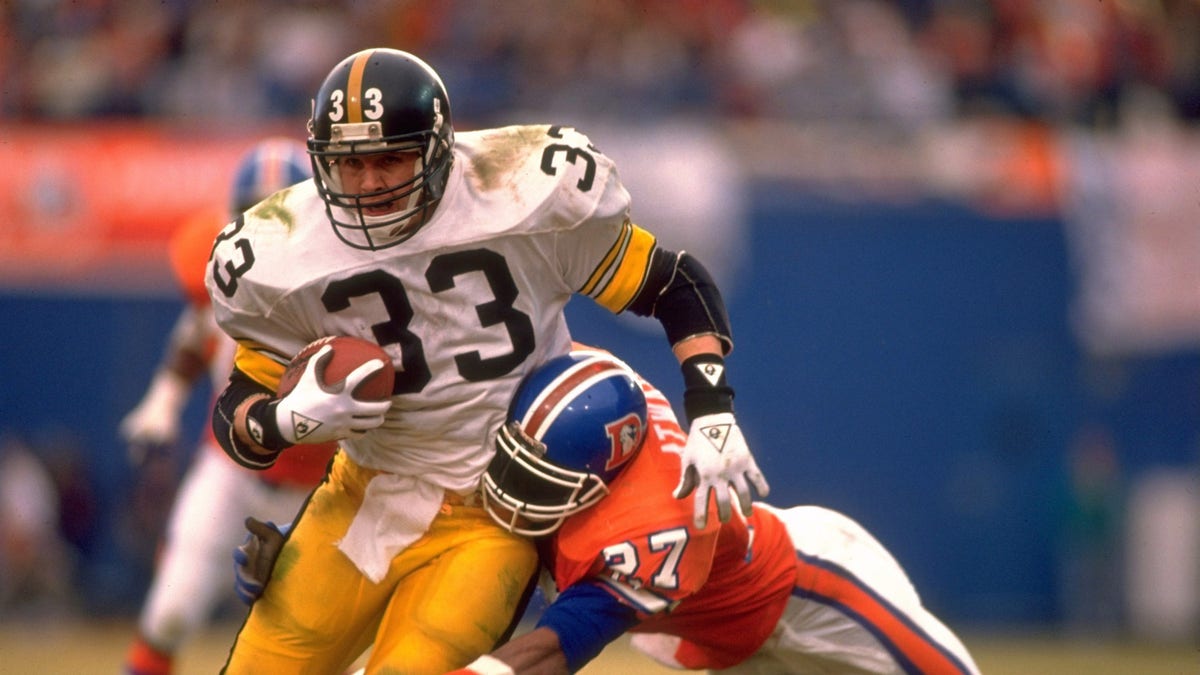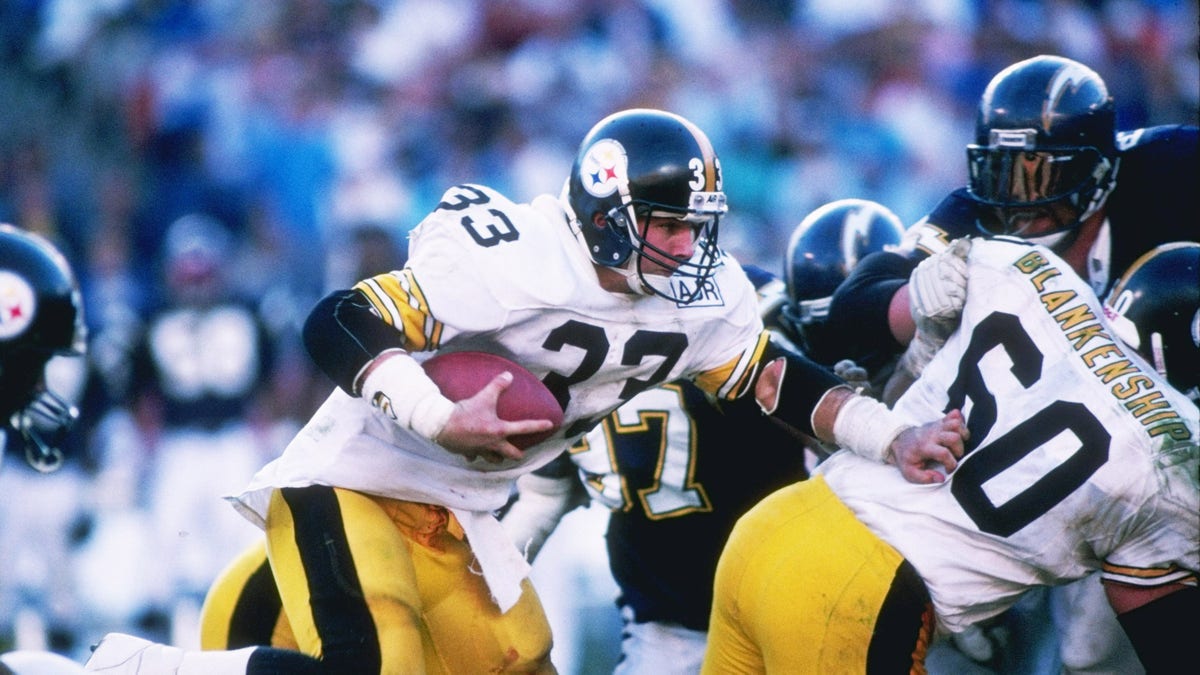Fox News Flash top headlines for February 11
Fox News Flash top headlines are here. Check out what's clicking on Foxnews.com.
Former NFL running back Merril Hoge played seven seasons with the Pittsburgh Steelers between 1987-93, before his career took a shocking turn one night in October 1994.
Hoge, 57, spoke to Fox News Digital about his career-ending concussion during his 1994 season with the Chicago Bears and the eye-opening experience that not only changed the trajectory of his career, but also his focus on head trauma and preventative care.
Hoge joined the Bears as a free agent in 1994 after a successful career in Pittsburgh, where he led the team in rushing and receiving in four of his first five years and became one of just two players in franchise history to rush for more than 100 yards in back-to-back playoff games.
PLAYING HURT, OFTEN WILLINGLY, IS COMMON FOR NFL PLAYERS

Pittsburgh Steelers Merril Hoge rushing vs. Denver Broncos Steve Atwater in Denver, Colorado, on Jan. 7, 1990. (Andy Hayt/Sports Illustrated via Getty Images)
The Idaho native was no stranger to concussions in his lengthy professional and collegiate career, but this would all change on Oct. 2, 1994, when he took a hard hit in a game against the Buffalo Bills which later caused him to go into cardiac arrest – he needed to be resuscitated in the locker room.
Nearly 28 years later, Hoge maintains that the concussion isn’t what ended his career but rather what happened several weeks prior to that game.
"This is where it is always misunderstood when people say concussions ended my career. No, it did not. Improper care did."
Hoge suffered a concussion several weeks before the one he sustained against Buffalo. He recalled the method by which a doctor cleared him at the time as "archaic," explaining that he was cleared after just five days, over the phone and after being asked, "How do you feel?"
CLICK HERE FOR MORE SPORTS COVERAGE ON FOXNEWS.COM
At the time there was no league-wide regulated concussion protocol in the NFL, although this has greatly changed over the years as player health and safety has seemingly taken center stage.

Merril Hoge of the Pittsburgh Steelers carries the ball and gets hit by Greg Kragen of the Denver Broncos during the AFC Divisional Playoffs Jan. 7, 1990 at Mile High Stadium in Denver, Colorado. (Focus on Sport/Getty Images)
"I was a part of the first group of players in sports history to ever do a baseline and that’s when the Pittsburgh Steelers established a cognitive baseline in 1991."
According to the University of Pittsburgh Medical Center, the Steelers developed a protocol within the organization under the direction of team neurosurgeon Joe Maroon, M.D. and Dr. Mark Lovell, and the behest of head coach Chuck Noll. After Hoge’s injury, the NFL called on Dr. Lovell to develop a league-wide neuropsychological-testing program.
"If that was Pittsburgh, that never happens," Hoge said of the injury.
He would later successfully sue the organization but as Hoge explains it, this was just the beginning of his new journey.
ANTONIO BROWN IS SUFFERING FROM CTE, FORMER PATRIOTS STAR SAYS
"I wanted change. I didn’t want this to happen to what I thought at the time was players in the NFL. I didn't realize where we evolved to is that it’s everywhere … my scope [at the time] was the NFL."

Merril Hoge of the Pittsburgh Steelers carries the ball against the Denver Broncos during the AFC Divisional Playoffs Jan. 7, 1990 at Mile High Stadium in Denver, Colorado. (Focus on Sport/Getty Images)
Hoge has not subscribed to the highly publicized recent findings connecting head trauma in contact sports and CTE, the brain degeneration also known as chronic traumatic encephalopathy. In 2018 he co-authored the book, "Brainwashed: The Bad Science Behind CTE and the Plot to Destroy Football!" that questioned the science behind the link.
"A lot of things have evolved. What happens in this arena is that people want to use what we know today and cast blame on [the past]," he told Fox News Digital. "[That’s] what's unfortunate today with the messaging that has gone on – which is incorrect. It is deplorable and harmful."
Hoge recently partnered up with SportGait, a brain wellness and medical technology company, to bring attention to the proper steps in identifying head trauma and managing concussions. The app was designed for those in the sports community, as well as the average person.
"The leading cause of head trauma is tripping and falling, the most dangerous environment where that is probably going to happen is the home," Hoge told Fox News. "That right there puts a scope of perspective that is never brought up. It is always sports, sports, sports… oftentimes in a home, there’s no protocol. There’s no evaluation process. And with the mental health aspect, identifying if you had an earlier understanding of signs and a better awareness you could help. You always hear people say ‘if I would’ve known.’"

Running back Merril Hoge of the Pittsburgh Steelers moves the ball during a game against the San Diego Chargers at Jack Murphy Stadium in San Diego, California in 1988. (Stephen Dunn /Allsport)
CLICK HERE TO GET THE FOX NEWS APP
Hoge said the app focuses on the environment in which head trauma can occur and how implementing proper care in the moment can prevent long-term injuries down the road and provides recovery tools needed for that.
"Most people live in fear of this because they don’t know it. I don’t live in fear of it even though it almost ended my career, it almost took my life because I went into cardiac arrest after my second hit. The most important thing with both of these is identifying it initially and the removal of it and that’s what we do well with the SportGait aspect of it."


